Brendon Jones
It’s fine. It's literally the definition of a fine movie. You’ve seen it before, you know every beat and outcome before the characters even do. Only question is how much escapism you’re looking for.
rsoonsa
THE SHAMROCK HANDICAP is the first film having an Irish motif that John Ford directed, a six reel delight set in Eire's County Kildare and in the United States, with a steeplechase background, mixing charged elements of comedy and sentimental drama, benefiting from a sterling cast including Leslie Fenton, Janet Gaynor, and Ford favourite J. Farrell MacDonald. After Sir Miles O'Hara (Louis Payne) is forced to sell most of his racing horses to American Orville Finch (Willard Louis) to pay debts, Finch persuades O'Hara's trainer and rider Neil Ross (Fenton) to leave with him for America to seek fortune, causing a sad separation between Neil and Sheila (Gaynor), daughter of Miles, who wishes to wed the young horseman. Fenton becomes permanently lame from a fall during a race in the U.S. but does not write of his injury to Sheila, and when an O'Shea entourage crosses the Atlantic to visit Neil, serious complications arise, with director Ford not relying solely upon sympathy for young Ross to propel his story to its very pleasing conclusion. Ford's distinctive stylistic methods garnish the film, at the same time providing a pastoral atmosphere synchronous with his perceptive visual character keynotes, brisk pacing, and always fresh, because unexpected, humorous invention, his protagonists defined by their actions and costumes, as in classic and medieval comedy. MacDonald plays Con O'Shea, Milo's handyman and friend, with always dependable Clair McDowell as Milo's wife, each player contributing a valuable turn in this well-edited affair, based upon an original story by Peter B. Kyne, popular American writer during the beginning years of the twentieth century. An upgraded print is in the collection of New York City's Museum of Modern Art, without tinting and 66 minutes, the best one to see, and it includes composer Philip Carli's epigrammatic piano solo score that offers a wealth of tuneful conceits.

